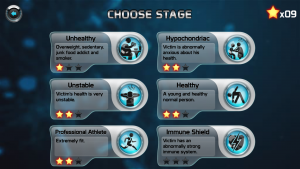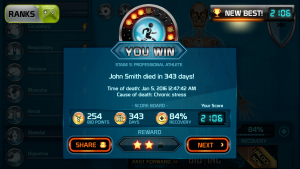Game analysed: Bio Inc.
While the goal of most doctor games is to save the patient, Bio Inc.’s objective is the exact opposite – to ensure that the patient dies, be it through giving diseases to the patient, increasing his risk factors, or hindering his recovery. Players collect viruses and bacteria which convert to “bio points”, which pay for the diseases, risk factors, or other things preventing his recovery. It is a race against time as players must kill the patient before recovery reaches 100%.
Website: http://www.playbioinc.com/
My experiences and actions
Bio Inc. is very refreshing, as the player is playing the role of a villain, making it the opposite of most games, where the player is a good person (Lens 2 – Surprise).
I played it on my Android phone with a touch screen. The controls are simple, only needing single taps (Elemental Tetrad – Technology).
There is a short description of my patient – “Overweight, sedentary, junk food addict and smoker”. The game has 12 stages, and each stage offers slightly different scenarios, allowing players to adopt different strategies to win (Lens 6 – Problem Solving).
A short tutorial made with overlays introduced me to the various aspects of the game – the body systems, where to spend my bio points, etc. (Elemental Tetrad – Mechanics)
The game pauses when I enter the page where I can spend my bio points, allowing me to slowly read through the descriptions and plan my next course of action – I was relieved that I won’t be missing out on any bio points while on this page. Since the only way to worsen the patient’s situation is to spend bio points on illnesses, risk factors, or other negative effects, the collection of bio points is crucial to winning the game (Lens 5 – Endogenous Value). The pause also allows me to read the details and various options thoroughly, without worrying that the patient may recover while I make my decisions.
As the game progressed, I realised that I am actually shaping the story of my patient, through the various diseases or characteristics that I am giving him. I can choose for my patient to be a senior citizen with a sedentary lifestyle and heart problems, or an asthmatic who suffers from severe nervous breakdowns (Elemental tetrad – Story). This is also what made the game fun for me, as I am able to give my patient different illnesses, rather than just killing him the same way every time (Lens 3 – Fun).
There are also sound effects – each time I give the patient a new illness, the patient will respond accordingly (e.g. coughing, wheezing). Graphics show a simulation of real human body systems, and more viruses and bacteria appear as the patient’s immune system weakens. There are bars to show the health of each system, and also an electrocardiogram monitor. These contribute to theme and creates an immersive experience for the player (Elemental Tetrad – Aesthetics, Lens 9 – Unification Theme).
Watching a friend play the game
Friend comments that the game does not explain why his character wants to kill the patient, nor does it cover the back-story of his character (Elemental Tetrad – Story).
Bio Inc. starts slow, with viruses/bacteria spawning only once every few seconds. Friend appears bored as he waits for them to appear. As the game progresses and the patient’s condition deteriorates, viruses/bacteria spawn faster, and friend seems to get more excited about the game (Elemental Tetrad – Mechanics, Lens 3 – Fun).
Friend gets more concerned as the patient’s recovery increases drastically after being sent to the emergency room, and he frantically tries to figure out how best to worsen the patient’s condition (Lens 6 – Problem Solving, Lens 2 – Surprise). As he formulates his strategy to win the game, he appears to be enjoying himself, telling me how he will make his patient die from stress (Lens 3 – Fun).
He managed to kill the patient when he was at 84% recovery, and he was visibly relieved and pleased. Upon seeing that he only got 2 stars (out of 3) for this game, he wanted to replay it to get 3 stars (Lens 5 – Endogenous Value). He also asked if it was possible to let the patient commit suicide and win the game, something I had not tried before (Lens 4 – Curiosity).
Overall, he said that the game mechanics were simple and easy to understand, the graphics were of good quality, but there is a lack of a good back story. However, the fun part of the game was being able to decide how to kill the patient, and the adrenaline rush he got as the patient’s recovery increased and had to hurry to collect bio points to buy more diseases (Lens 1 – Essential Experience).
Comparison and Analysis
My friend and I shared a lot of similar views about the game, but from observing my friend, I realised that different people will have different experiences based on how they play the game and their own personalities.
I had played through the front part of the game without complain, and only realised that it was quite slow in the beginning when my friend looked bored at the start of the game. While this is part of the game mechanics, it might cause less patient players to abandon the game before being able to experience the whole game. I feel that Bio Inc. can also improve by having a back story for the character the player is playing to improve the Story aspect of the Elemental Tetrad. We both found the aesthetics to be pleasing, and given the simple technology employed, the game comes together as an entertaining casual game. (Lens 7 – Elemental Tetrad)
While there is some endogenous value in the game, such as the bio points we need to collect, and the star rating for each stage (with a maximum of 3 stars), I found that Bio Inc. can attract players to play the game more by having endogenous value that can be sustained – the current design does not allow any cumulative benefits between stages, and while the stages feature patients with slightly different conditions, they may seem repetitive and players may be less inclined to play through the different stages. (Lens 5 – Endogenous Value, affecting Lens 3 – Fun)
Also, the game does not any type of interaction between players (it is purely a single player game). I feel that not being able to play with friends may lower the pull of the game, as having social elements in the game will help make it more fun to play as players either help one another to achieve a goal, or compete against each other to see who has better skills. (Lens 3 – Fun)
However, I find that the game does well in balancing the different illnesses and risk factors, as I always find it a challenge to kill the patient in time, since the patient will be sent to the emergency room once his condition deteriorates to a certain extent, increasing the recovery rate greatly. (Lens 6 – Problem Solving, Lens 3 – Fun)
The random events in the game also add to the experience, making it less predictable. A flu epidemic once helped me to turn the tables on the patient, helping me win the game when I would have lost. (Lens 2 – Surprise, Lens 3 – Fun)
All in all, the game provides a fun and refreshing perspective and serves well as a casual game that can be picked up quickly, but needs some work to increase its replay value since the stages are quite similar and actions are repetitive, and there is a lack of a social component. (Lens 1 – Essential Experience)


